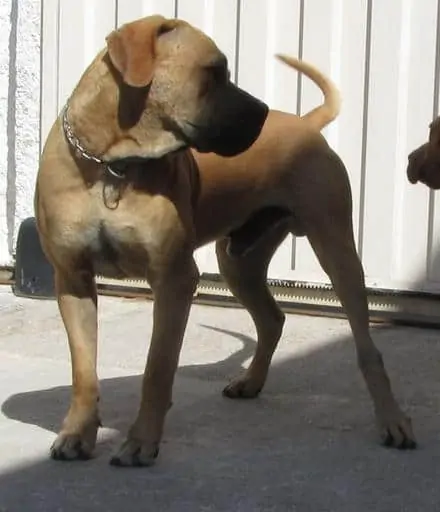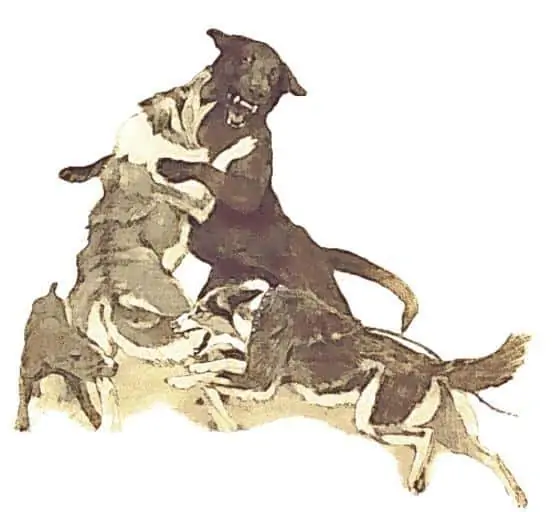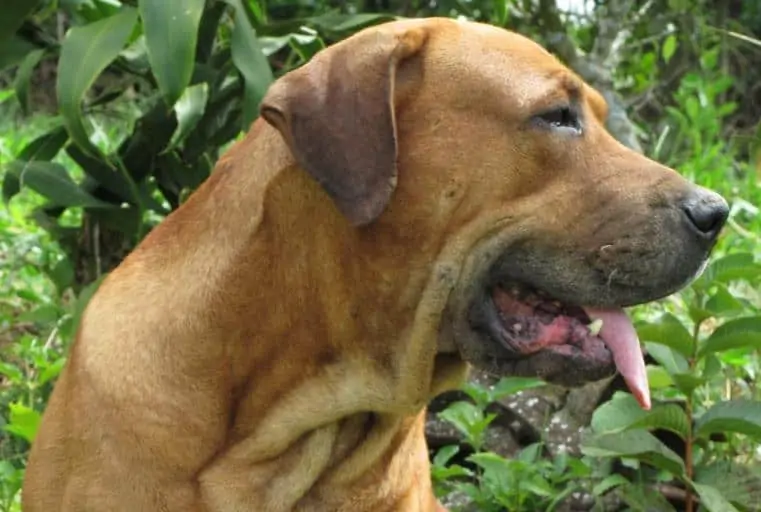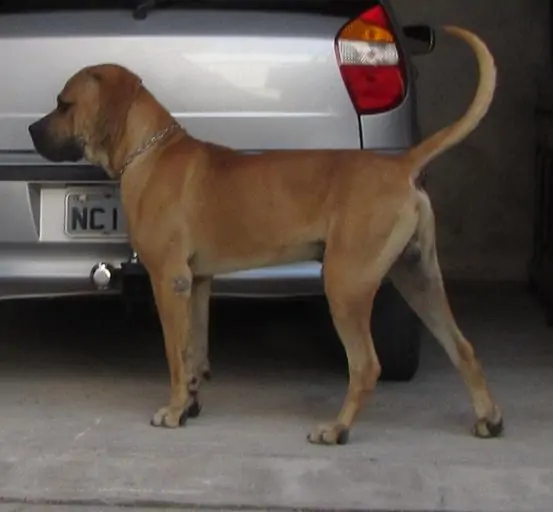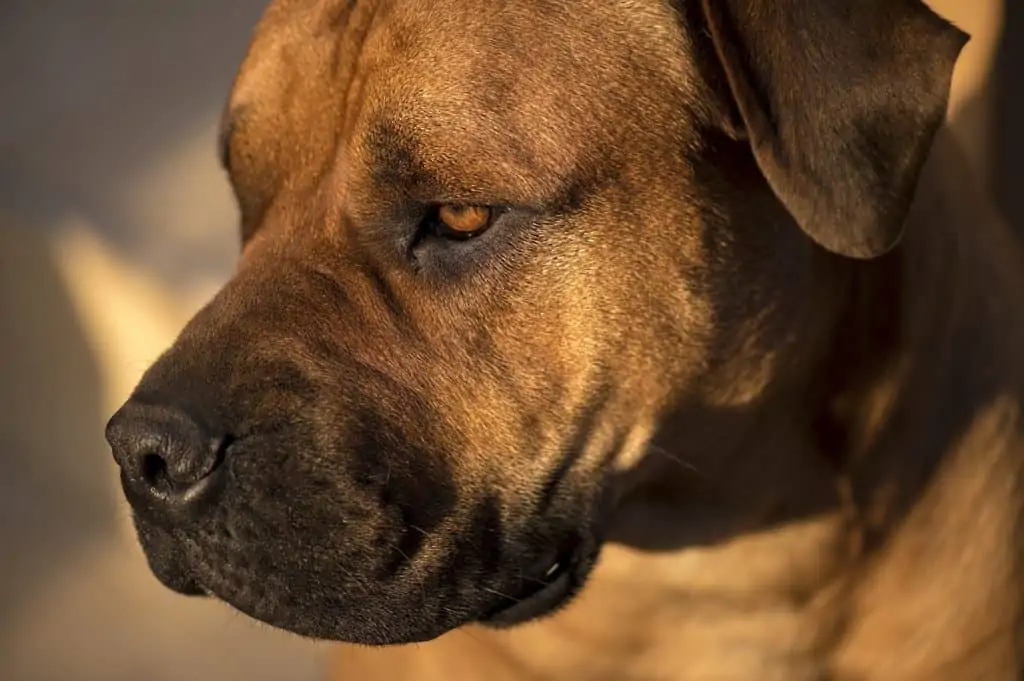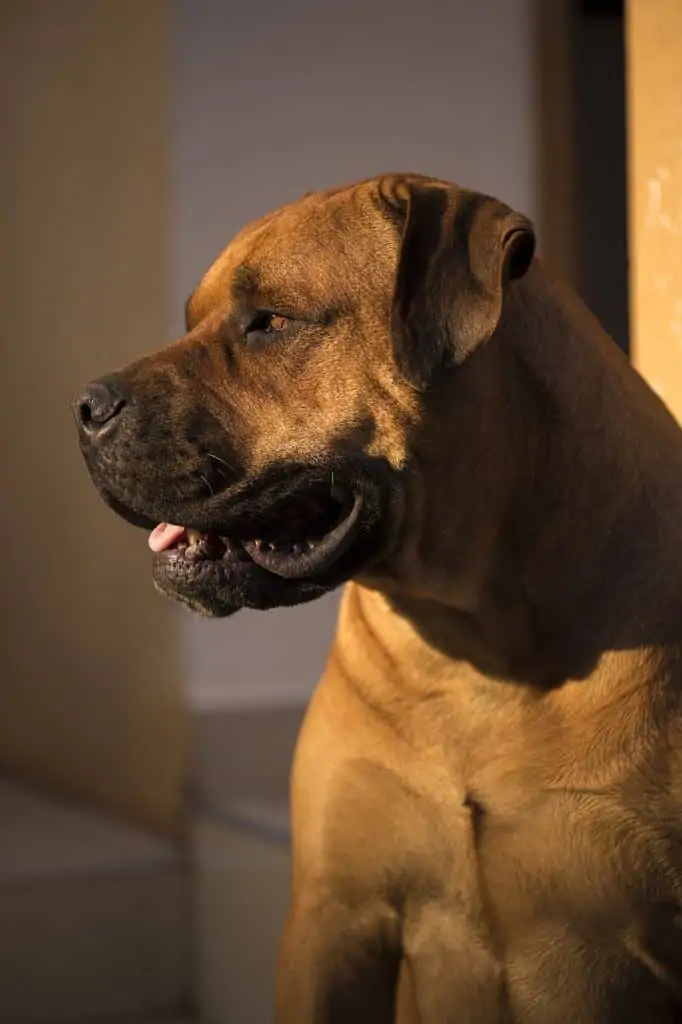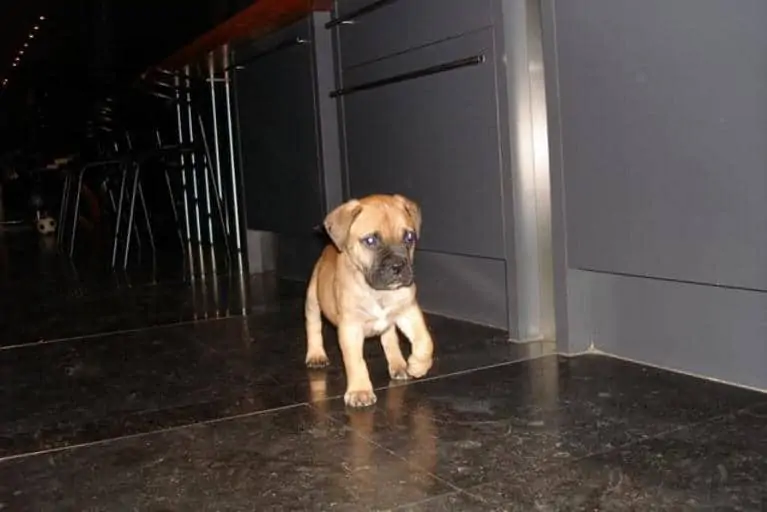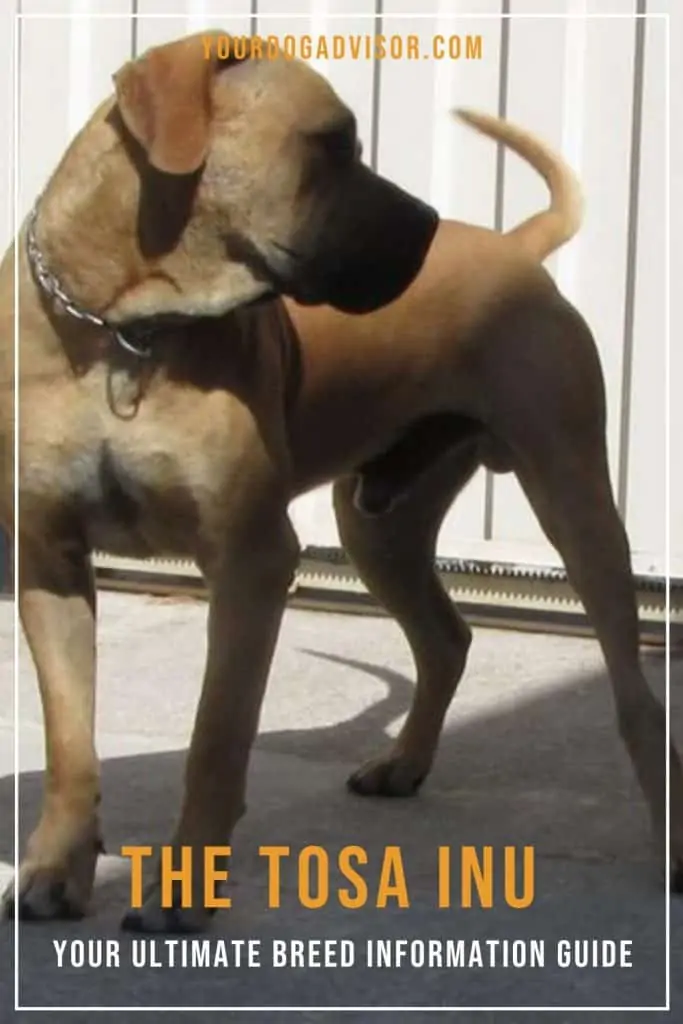If you’ve only recently heard of the Tosa Inu dog, you’re not alone. Though ancient, this is a Japanese dog breed that is exceedingly rare, especially in the United States. Still, this is an incredible dog revered by many with great respect and honor.
Are you interested in learning more about the Tosa Inu dog and discovering if this powerful and devoted breed would make the right addition to your home or family? Then keep reading because that’s what we’re here to discuss!
Contents
Introducing The Tosa Inu – A Brief Breed Overview
The Tosa Inu is considered a rare Japanese breed and is even banned in many regions.
Other Names: The Japanese Mastiff, The Tosa Ken, The Tosa Token, The Tosa Dog, and The Japanese Fighting Dog
Height: 21.5 to 23.5 Inches
Weight: 100 to 200 Pounds
Temperament: Devoted, Mild-Mannered, Courageous, Quiet
Best Suited For: Experienced Dog Owners
Lifespan: 10 to 12 Years
Health Issues: Hip Dysplasia, Gastric Dilatation Volvulus, Skin Issues, Allergies, Elbow Dysplasia, Hyperkalaemia, And Hypothyroidism
Tosa Inu Overview:
The Tosa Inu is a product of Japanese dog fighting, which has origins dating back as far as the 1400’s. A likely mix between several large breeds, Tosa Inu dogs were originally designed to be used in the fighting ring.
In fact, these are the only dogs today that are still legally used in dog fighting in Japan, though animal welfare groups are actively working to put an end to this pastime.
With all of that being said, the Tosa Inu is also a highly respected dog in Japan, often revered to be the same level as human sumo wrestlers. Aside from being used as fighting dogs, Tosa Inu dogs are also commonly used as guard dogs and devoted family companions. They are incredibly loyal, attentive, and mild-mannered, making them ideal for experienced dog owners looking for a trainable and hard working canine.
However, in the wrong hands Tosa Inus can become catastrophic. Without proper training, socialization, exercise and attention every day, they are prone to developing behavioral issues including stubbornness and even aggression.
If you have your heart set on a Tosa Inu, it’s also important to note that this incredible dog may not be legal in your area. In fact, this is a breed that is actually banned in several countries. Furthermore, the Tosa Inu is considered incredibly rare, which makes finding breeders and dogs difficult.
Still, with diligence and resourcefulness, it is possible to find quality Tosa Inu breeders in the United States and even throughout the world.
But before you decide if this is the right dog for you, let’s learn more about him!
A Controversial Past – The Tosa Inu History and Origin
The Tosa Inu is one of the only dogs legally still used for fighting in Japan.
According to the American Kennel Club, Japan has a very long history of dog fighting. The blood sports likely began back in the early 14th century, and it was around this time the island of Shikoku produced a dog that would go unrivaled for centuries. This dog was known as the Shikoku Inu.
This breed was a marvel to all who heard of him, and it wasn’t long before foreigners arrived and began adding their twist to this incredible dog.
In 1854, breed enthusiasts and dogfighters began working to create their own versions of this formidable and unequalied fighting breed.
This involved mixing the Shikoku Inu with other foreign breeds, making a variety of different hybrid dogs for their own uses and needs.
Eventually, the Tosa Inu was born and is a mix of a number of different Western dogs including the Great Dane, the Bulldog, the German Shorthaired Pointer, and perhaps even the Bull Terrier and the Saint Bernard.
Today, Tosa Inu dogs are considered the only breed still legally used for fighting in Japan, as we mentioned above. However, they are also beloved companions, guard dogs and working dogs for willing and committed dog owners throughout the world.
Is The Tosa Inu Dangerous? Let’s Talk Temperament!
In the right hands, a Tosa Inu can be a loyal, friendly and devoted dog. However, in the wrong hands this dog can be a serious challenge.
Some sources will say that the Tosa Inu can suffer from behavioral issues, and this is a dog that has been deemed dangerous in many regions throughout the United States and even the world.
The truth is, like any dog the Tosa Inu requires the correct upbringing to ensure he grows up happy, healthy and well-rounded. This is certainly not the right breed for every owner, and he needs a committed owner and family that understands the importance of ensuring their dog is properly trained and socialized not only at an early age, but also throughout his life.
Tosa Inus are massive dogs and they certainly have a controversial past, but when raised correctly their temperament is described as mild-mannered, devoted, calm and quiet. They are quite affectionate to their human family and aggression towards people is considered rare for the breed.
However, they can be aggressive and territorial towards other dogs they are not raised with, and they are capable of showing wariness and suspicion towards strangers they consider to be intruding near their home or people.
Tosa Inu dogs can make good family dogs in the right home and with responsible owners. They are gentle with youngsters they are raised with and even watchful and protective. Of course, it’s still never a good idea to leave children unsupervised with any dog, and especially a large and powerful dog like the Tosa Inu.
Refrain from letting children rough play with the Tosa Inu, and work with age appropriate children on ways to identify and understand canine body language.
Having a better idea of how a dog is feeling can help reduce the chances of dog bites in and even outside of the home.
We should point out here that if Tosa Inu dogs are not raised properly, they can become very difficult and overwhelming for their family. They are massive dogs who are known to mature quite late in life, with the American Kennel Club stating that these dogs likely won’t reach maturity until they are at least four years old.
This could mean that your Tosa Inu behaves in a puppy-like and stubborn way for quite some time, and training and socialization will need to be conducted consistently and with patience.
For this reason, we do not recommend the Tosa Inu to novice dog owners or dog owners who do not have the time to commit to this one of a kind dog.
Tips On Training And Socializing A Tosa Inu Dog
Training and socialization should begin early and continue on throughout your dog’s lifetime.
Because the Tosa Inu is such a large and powerful dog with guarding instincts, training and socialization are imperative to his upbringing.
This is a dog that will require routine socialization and training beginning from early puppyhood. Getting him from a reputable breeder or source who has worked with him from birth is also going to be beneficial to ensuring your dog is mentally sound and trainable as he ages.
Let’s Talk About Training A Tosa Inu
When it comes to training, the Tosa Inu can be a joy to work with so long as you start off with him on the right foot. Training should begin as early as possible during puppyhood and should be done using positive reinforcement training techniques utilizing treats and praise.
While it may be necessary to be firm with your Tosa Inu, it’s not a good idea to use harsh punishments or scolding during training sessions. Not only could this cause your dog to shut down during training, it could lead to fear-based aggression and even deteriorate the bond between the two of you.
Keep in mind that the Tosa Inu is a naturally intelligent and devoted dog. Once bonded with his family, he will be keen to learn and eager to please. Your approval is all he really wants, so showing him what to do as opposed to what not to do will make all the difference when it comes to training.
It’s also important to use proper treats when training a Tosa Inu. Training treats that are high value are especially helpful and will ensure your Tosa Inu keeps his attention on you. High value treats are typically going to be small, chewy and very smelly.
Socializing A Tosa Inu
Along with training your Tosa Inu at the earliest age possible, it’s also incredibly important that you begin socializing your Tosa Inu as soon as it is safe to do so. Before your puppy is fully vaccinated, it won’t be safe to introduce him to many outsiders and other dogs. However, you can begin working on socialization by taking your Tosa Inu puppy for car rides and introducing him to new sights and sounds from a safe distance.
Once your puppy is vaccinated and protected, try and introduce him to as many new people, places, pets, sights, sounds and experiences as possible. Ensuring these experiences are positive for your Tosa Inu will help reduce fear and anxiety as your dog ages.
With that being said, remember that you can’t always control how your dog perceives certain situations, and it’s best not to force your Tosa Inu into a new experience or situation that is clearly frightening for him.
This could actually increase behavioral issues down the road and lead to a heightened chance of fear based aggressive tendencies as your dog ages.
How To Ensure Your Tosa Inu Is Getting Enough Exercise And Mental Stimulation
The Tosa Inu is a very smart and athletic dog. As such, he requires plenty of exercise and mental stimulation.
The Tosa Inu is indeed a large dog. He has DNA tying him to some of the world’s largest breeds including Great Danes and Mastiffs! And while the Tosa Inu enjoys relaxing and is relatively calm overall, he still needs routine exercise and mental stimulation each and every day to ensure he stays happy and healthy.
Exercising A Tosa Inu
When it comes to exercise, your Tosa Inu is going to need at least an hour to two hours of dedicated exercise each and every day. This could include a long walk once in the morning and once in the evening, good hikes, or free runs in a securely fenced yard or on lots of land.
Because Tosa Inu dogs may have some dog-based aggressive tendencies, we would not recommend this dog for excursions to dog parks.
We also suggest ensuring your dog is walked on a secure leash and harness that provides you with plenty of control.
While the Tosa Inu is not necessarily a dog known to pull ahead during walks, he could bark or lunge at other dogs he sees on the street, especially if he hasn’t been adequately trained or socilizaed.
Still, we would advise against the use of choke chains and prong collars. Instead, we suggest using a front clip dog harness or Halti lead that reduces pulling and provides you with the ultimate control while ensuring your dog is comfortable and safe.
ICEFANG Tactical Dog Harness
No products found.
For very large, powerful dogs like the Tosa Inu, we would recommend investing in a tactical dog harness like the one listed above by the ICEFANG Store. This dog harness is made with military grade material and is designed to provide both you and your dog with comfort and confidence during walks.
This harness clips both in the font and in the back, optimizing your control. It also includes a handle on the back. The harness is adjustable and can be fitted to your dog’s unique size. It also comes in several colors and three different sizes.
The Mental Stimulation Needs Of A Tosa Inu
The Tosa Inu is a bred working dog, but he’s relatively calm during the day so long as his exercise needs are met. He’s typically happy watching his family’s activities from a nice cozy bed, but like all dogs your Tosa Inu is going to need mental stimulation to keep his mind sharp and happy.
Because this is such a devoted dog, the Tosa Inu will enjoy fun training sessions designed to test or challenge him. This could include learning tricks or cues just for fun, or completing short obstacle courses you make for him in your home or yard to win treats and praise.
KONGs and Puzzle Toys for large breed dogs can also help reduce behavioral issues like chewing, anxiety, stress and barking due to boredom while you are away.
How To Groom And Care For A Tosa Inu Dog
Tosa Inu dogs have short, low shedding coats. They require routine brushing, bathing and other care to ensure they are healthy.
The Tosa Inu has a short, smooth coat that sheds lightly year around. However, he may shed more heavily during the shedding season in spring and fall. Like most other dog breeds and mixes with this type of coat, the Tosa Inu will need to be brushed occasionally to help collect dirt and debris, as well as loose hair that has built up over time.
Otherwise, he’s a relatively easy breed to keep clean and healthy with basic grooming techniques and routines.
The Tosa Inu should have a bath once every six to eight weeks and a dog-safe shampoo free of dyes, alcohols, parabens or other ingredients that could strip his coat of his natural oils.
Along with occasional bathing and brushing, your Tosa Inu will also need to have his ears checked and cleaned regularly to keep them free of waxy buildup, debris, moisture or wax that could lead to ear infections down the road.
This breed should also have his nails trimmed down once every few weeks with a canine nail trimmer or nail grinder, and his teeth will need to be brushed at least once a day with a dog safe toothbrush and toothpaste.
Arm & Hammer Toothbrush For Dogs
No products found.
One of the tooth brushing kids for dogs we would recommend when it comes to the Tosa Inu is the Arm & Hammer tooth brushing kit. This kit includes a long toothbrush as well as a finger brush, and it even includes a flavored dog-safe toothpaste that your dog should enjoy.
Depending on your dog’s age, you can purchase a puppy training toothbrushing kit or an adult tooth brushing kit. You can also order the toothpaste in different flavors depending on your dog’s preference.
What You Should Know About The Tosa Inu Dog’s Health And Lifespan
Like all dogs, the Tosa Inu can be prone to suffering from a number of genetic health issues you should be aware of.
Tosa Inus tend to have an average lifespan of between 10 and 12 years, though some can live longer. Remember, however, that this is a giant dog breed that can suffer from some unique health issues due to his size.
Some of the most common health issues in a Tosa Inu include:
- Hip Dysplasia
- Gastric Dilatation Volvulus (AKA Bloat)
- Skin Problems
- Allergies
- Elbow Dysplasia
- Hyperkalaemia
- And Hypothyroidism
Although it can be difficult to predict or prevent health issues from developing in a Tosa Inu as he ages, there are steps you can take to ensure your dog lives his healthiest life possible.
Get Your Dog From A Reputable Source
First and foremost, it’s imperative that you get your Tosa Inu dog through a reputable source. Make sure you obtain a puppy through a licensed breeder who understands the importance of responsible breeding practices, or through a shelter that is able to provide you with some background on your specific dog’s history.
Have Your Tosa Inu Health Screened
If you do go through a breeder, you’ll likely be provided with paperwork proving your dog’s pedigree along with certificates proving your Tosa Inu has been screened and cleared of any serious health issues.
However, a canine DNA kit can provide your dog with a more comprehensive list of potential health issues and give you a better idea of what you should keep an eye out for in the future.
Stick To A Good Grooming & Exercise Routine
Grooming and exercise go hand-in-hand when it comes to ensuring your Tosa Inu is looking and feeling his best. Try to stick to a schedule and use quality grooming tools and supplies that are designed for this particular type of dog.
Make Sure Your Tosa Inu Is On A Quality Dog Food And Consider A Puzzle Feeder
Like many large, deep chested dog breeds, the Tosa Inu can be susceptible to Gastric Dilatation Volvulus, also known as Bloat. This is a life threatening condition that can come on suddenly and is often caused by eating or drinking too quickly, eating something your dog should not have eaten, or eating or drinking immediately after exercise.
Bloat occurs when air fills the stomach and causes other organs to flip, thus cutting off the blood supply to the lower part of your dog’s body and sending him into shock.
You can help combat bloat by ensuring your dog is on a quality dog food specified for his age, weight and activity level, as well as feeding him smaller meals throughout the day.
We also suggest considering investing in a puzzle feeder to help slow your dog down when he eats, and refraining from allowing your dog to eat or drink immediately after intensive play or exercise.
Maintain Routine Veterinarian Visits And Wellness Exams
Last but not least, we suggest sticking to routine vet visits and wellness exams with your veterinarian. Most vets recommend that large dog breeds like the Tosa Inu be seen for checkups at least once a year until they are around seven years old, at which point they should be seen twice a year.
What Is The Ideal Home Type For A Tosa Inu?
The ideal owner of a Tosa is going to be an experienced one.
Although the Tosa Inu can make a wonderful companion, he is a dog that requires lots of time, commitment and work. Remember, this is a breed that could be prone to developing behavioral issues if all of his needs are not adequately met, and he also matures slower than most other dogs of his size.
For this reason, the ideal owner for a Tosa Inu dog would be an owner with a strong understanding of the importance of training, socialization and exercise. This owner should also have experience and comprehension of working dog breeds and a flexible schedule that allows them to spend lots of quality time with their dog.
Along with an experienced and committed dog owner, the Tosa Inu will also need plenty of space. This is a very large dog who will do best in homes with room to accommodate him, including a large, securely fenced yard where he can play or roam freely and safely.
Though quiet, the Tosa Inu is not a good apartment dog. His large size and potential wariness of strangers and other dogs means he could be problematic in smaller spaces with thin walls, especially with a number of people coming and going often. ‘
We should also remind you here that the Tosa Inu is a dog that is included on many banned breed lists. Before deciding to invest in the Tosa Inu, it’s important to consider the breed laws and legislation in your specific area to ensure this breed is allowed there.
How To Find A Healthy Tosa Inu Dog To Call your Own
Finding a Tosa Inu puppy could be difficult, as these dogs are considered rare.
Finding a Tosa Inu puppy or rescue could prove difficult. This is due to the fact that Tosa Inu dogs are so rare here in the United States. With that said, it is possible to find reputable breeders and potentially even rescues or shelters dedicated to this dog. It will likely just take you time and research.
If you opt to go through a breeder, be prepared to spend between $1,000 and $3,000 for this dog breed.
Because Tosa Inu dogs can be so high maintenance, we encourage you to be cautious about who you buy from and make sure the sources you go through are reputable.
This means you should avoid backyard breeders, uncertified online sellers, or any breeder attempting to sell a Tosa Inu puppy for much more or much less than you know them to be worth.
If you prefer to go through a rescue, you may have to do a bit of research. Many of these dogs wind up in breed specific shelters dedicated to giant breed dogs like Mastiffs or Great Danes.
When you are going through a rescue, be sure to ask plenty of questions and prepare to spend a small fee of between $250 to $500.
This fee will typically cover a free initial vet exam, as well as some basic initial training. Other hiddens savings and benefits of going through a rescue include adopting a dog that has potentially already been spayed or neutered and potentially even microchipped.
Of course, adopting or buying your Tosa Inu is up to you and the decision will depend on your unique needs and situation. Just remember that this dog is not the ideal dog for novice dog owners, though he can make an excellent companion for those with plenty of experience.
So, what do you think about Tosa Inu now that you’ve learned more about him? Have you decided that this is the right dog for you? Tell us why or why not in the comment section below.
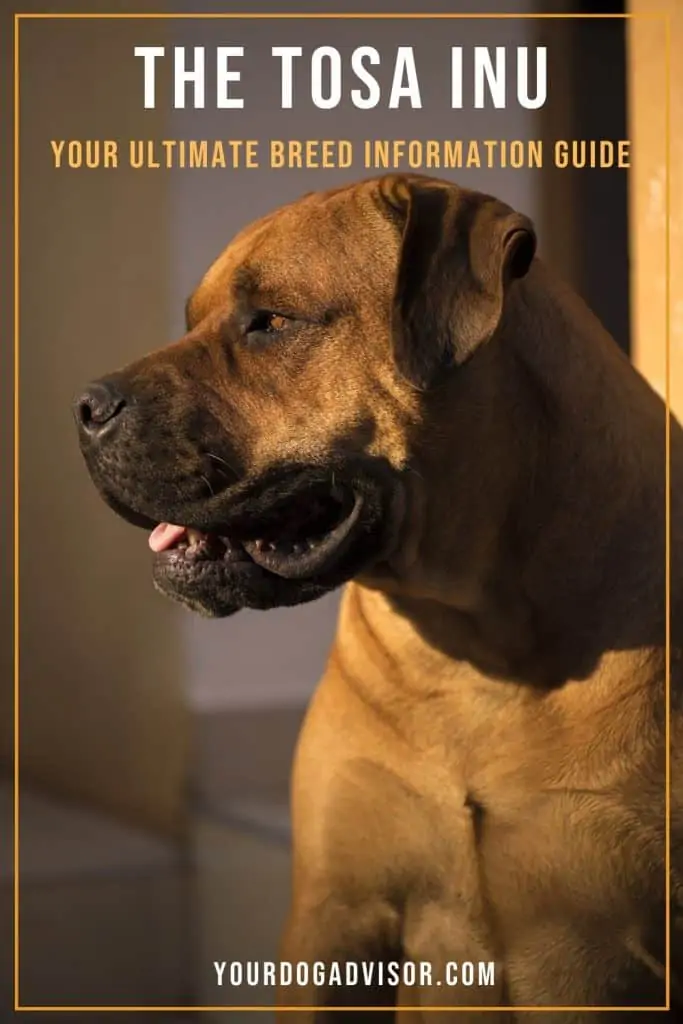

Jen Jones is a professional dog trainer and behavior specialist with more than 25 years of experience. As the founder of ‘Your Dog Advisor’ and the ‘Canine Connection’ rehabilitation center, she applies a holistic, empathetic approach, aiming to address root causes rather than merely treating symptoms.
Well known for her intuitive and compassionate approach, Jen adopts scientifically-proven, reward-based methods, encouraging positive reinforcement over punishment. Jen specializes in obedience training, behavior modification, and puppy socialization. Her innovative methods, particularly in addressing anxiety and aggression issues, have been widely recognized. Jen has worked with many of the world’s leading dog behaviorists and in her free time volunteers with local animal shelters and rescue groups.
